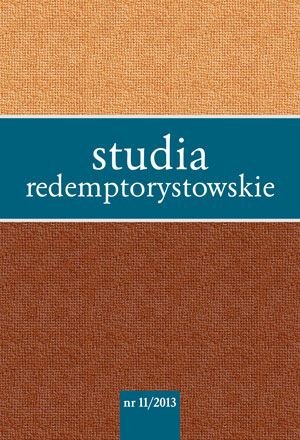Swietowanie w chrześcijaństwie w IV–V wieku
Celebrations in christianity in IV–V century
Author(s): Konrad KomarnickiSubject(s): Christian Theology and Religion
Published by: Warszawska Prowincja Redemptorystów
Keywords: Feasting; celebration; Salminius Hermias Sozomenus; Socrates of Constantinople; Sozomen; Egeria; Egeria’s Travels; common; ancient Church; First Council of Nicaea; calculation of the date of Easter; Constantine; Holy Land; Epiphany; Nativity of Christ; Ho
Summary/Abstract: Human time, no matter to what culture or religion a man belongs, is filled with celebrations that give rhythm to his life and help him capture the essence of his existence. Also Christianity over the centuries worked out various forms of specific celebration. Th e goal of this text is to look at the character of celebrate in the fourth and fifth centuries and to determine how the Christian writers wrote about the celebration. The first sources that author considered are two ancient texts of Socrates of Constantinople (Socrates Scholasticus) and Sozomen (Salminius Hermias Sozomenus) with the same names: Historia Ecclesiastica. In both works there are little chapters, in which appear the mention of the celebration, the majority of them is associated with Feast of the Passover and The First Council of Nicaea, others occur mainly on the margins of the narrative. This is because the history of the Church is here treated primarily as ‘political’ history, shaped by the decisions of great personages of the Church. The most important conclusion that emerges from these two texts is the observation that the differences in the way of celebration are not a source of division, but most of all divisions for doctrinal reasons manifest themselves in a separate celebration. The second source is The Travels of Egeria, also called The Pilgrimage of Aetheria (Itinerarium Egeriae), a letter describing the author’s travel to the holy places. In her report Egeria devotes much attention to the description of those involved in the celebration of subsequent festivals. The modern reader is struck by the generosity of crowds gathered in prayer and their vivid faith that motivates them to make long prayers going for hours. Celebration of Christians in the fourth and fifth centuries was an expression of a vivid faith. Their religion permeated life in all dimensions, and determined the essence of who they were. It was touching the inexpressible, the main aim was above all communion with Christ and the Church. Originally Christians celebrated entirely in the community of the Church, which gives a more or less clear framework to all that can be considered for celebration.
Journal: Studia Redemptorystowskie
- Issue Year: 2013
- Issue No: 11
- Page Range: 201-229
- Page Count: 28
- Language: Polish

